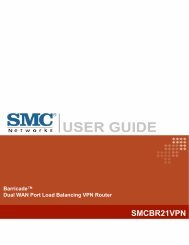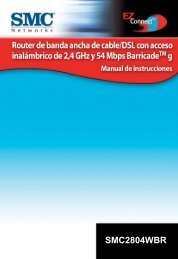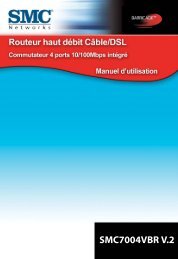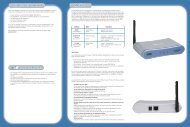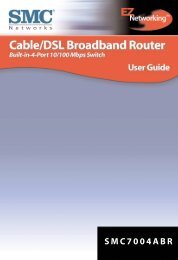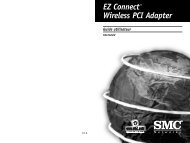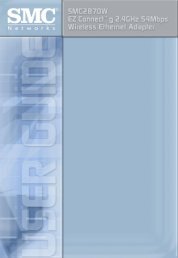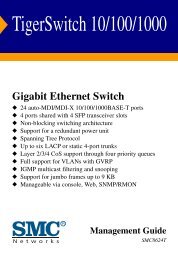Installation Guide - SMC
Installation Guide - SMC
Installation Guide - SMC
You also want an ePaper? Increase the reach of your titles
YUMPU automatically turns print PDFs into web optimized ePapers that Google loves.
DESCRIPTION OF HARDWARE<br />
connection (in-band) using Telnet, the on-board web agent, or<br />
SNMP-based network management software.<br />
The management port provides a dedicated management channel that<br />
operates outside of the data transport network. This makes it possible to<br />
re-configure or troubleshoot the switch over either a local or remote<br />
connection when access via the data channel is not possible or deemed<br />
insecure.<br />
For a detailed description of the switch’s advanced features, refer to the<br />
Management <strong>Guide</strong>.<br />
Description of Hardware<br />
This device is an intelligent Layer 2 VDSL2 switch with 16 VDSL ports for<br />
subscriber access to the data network, and two Gigabit Ethernet<br />
combination ports * for uplink traffic. The uplink ports are implemented as<br />
10/100/1000BASE-T ports shared with SFP transceiver slots (see Figure<br />
1-1, Ports 17-18). The switch also includes one 10/100BASE-TX port for<br />
dedicated management access (which can be operated outside the data<br />
channel).<br />
The VDSL switch combines data and voice signals for delivery over<br />
standard telephone cable to multiple users in residential or commercial<br />
buildings. Ethernet data signals are received on the switch uplink port(s)<br />
and passed to the 16 VDSL ports on the front panel via 16 internal<br />
Ethernet ports.<br />
* If an SFP transceiver is plugged in, the corresponding RJ-45 port (17 or 18) is disabled.<br />
1-5



